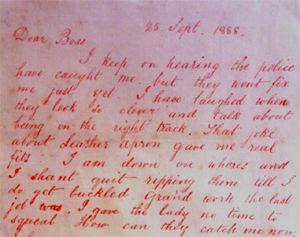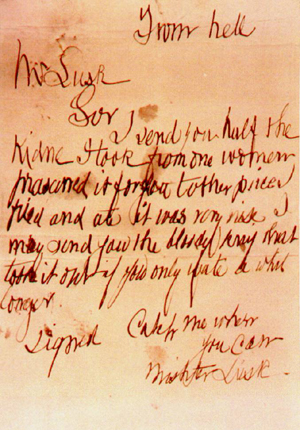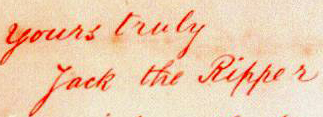It may seem a little off-topic to post theories on Jack the Ripper to a site devoted to scifi and fantasy, but when I consider the impact that the Victorian Era had upon genre fiction, and the impact the Whitechapel murders had upon the Victorian imagination, I don’t think it too great a stretch. Jack the Ripper is a near-mythic figure, en par with Sherlock Holmes, Dracula and certainly surpassing Dr. Jekyll in his power to intrigue us.
I’ve compared the Ripper mostly to fictional characters because, in terms of his place in the popular imagination, that’s just what he is. When people think of Jack the Ripper and his crimes, they’re usually picturing something far removed from what really happened. And that’s not necessarily a bad thing; in him we witness the creation of a modern demon, and as such he gives us a glimpse of how some ancient monsters may have come to be.
Aside from the fantasy that surrounds him, there were real murders, real prostitutes killed and mutilated. The merging of grim truth and pop-culture boogeyman created a topic of ongoing fascination for generations despite far more prolific modern killers. After all, who among us walks down a dark alley and thinks of Peter Sutcliffe? Fear of Jack remains potent in part because in all likelihood, no matter how advanced our forensic sciences may become, we’ll never know the full story.
You’d Say Anything But Your Prayers
No doubt most of the readers here are pretty familiar with the social and economic climate of the later Victorian period, so I’ll not go into that except to bring up a few salient points. First, the East End had seen a massive influx of Eastern European immigrants. Many were Jews, and anti-Semitism surged at the time. Poverty and overcrowding abounded. To say prostitution was rampant is putting it very mildly. Estimates vary, but there may have been forty or fifty thousand prostitutes in London around the time of the murders.

Also, tabloid journalism was in its infancy, but grew up fast. Social unrest, as well as the upper class fear of its supposed inferiors, and the poorer classes distrust of the upper, and everyone’s distrust of immigrants, created an atmosphere of speculation and paranoia that significantly boosted the popularity of cheap scandal sheets.
Onto this scene stepped our boy Jack, and the tabloids recognized a definite meal ticket when they saw one. It’s important to remember that a tabloid, since the very beginning, has been an advertisement medium. Its job is to sell, not to be accurate or informative or to catch criminals.
A Partial Profile
I am an amateur in all matters criminological. I make no claim to any expertise in forensics or psychological profiling. What I have is curiosity and plenty of it. For the opinions of genuine experts, I would direct you to the books of Robert Ressler and John Douglas.
If psychological profiling is legit (and I think it is) there are some generalities we can assume about the killer’s personality, given of course that a full profile is impossible due to the lack of reliable evidence. He would probably have been socially awkward, of low income, poorly educated, very familiar with the area, known to be violent and misogynistic. He may have endured a financial hardship or radical change in his personal life before the crimes began. Unfortunately, that could describe hundreds of residents of the East End at the time.

Though profiling can’t pinpoint exactly who he was, it can give a pretty clear picture of who he wasn’t. We can dispense, I think, with the dopey theories of various royal and/or Masonic conspiracies, mad doctors and tortured artists. And for fuck’s sake, it wasn’t Lewis Carroll. He hunted snarks, not trugmoldies. (I present my own theory later. Other Ripper enthusiasts may feel free to “rip” my ideas apart. That’s traditional among Ripperologists.)
The tabloids put forward all manner o’cock-eyed theories. He was a posh, dapper fellow. He was a crazed Polish Jew immigrant. He was a doctor, an abortionist, a hunter, a tailor, sailor, butcher, a baker, a candlestick maker. He was whoever would sell that day. The public lapped it up, then as now.
The name Jack the Ripper comes from the famous Dear Boss letter, written to the Central News Agency of London, in which the author ends by writing, “Yours truly, Jack the Ripper” and in a postscript says, “Don’t mind me giving the trade name.”

The authenticity of the letter is disputed among Ripperologists. That said, Ripperologists dispute just about everything eventually. That the letter was written to a news agency has prompted some theorists to suspect it was written by a journalist. To be sure, there is a dramatic flare to it, and an air of sophistication. The penmanship, at least, indicates that the author was a reasonably educated person (if not necessarily a journalist). I don’t think it unfair to say it isn’t the sort of correspondence one would expect from a dockworker or butcher.
Compare this to the equally famous From Hell letter. I think any rational observer would be hard-pressed to think this letter and Dear Boss came from the same hand. For starters, From Hell doesn’t bother with the theatrics of red ink or flashy phrases like “I am down on whores and shan’t stop ripping them until I do get buckled.” No, From Hell is a far sloppier and less literate presentation. The lines meander, letter sizes shift and the spelling is all over the place. Also, it’s written to Mr. Lusk of the Whitechapel Vigilance Committee, a civilian posse. Seems to this armchair sleuth that writing to a local, familiar authority is a very different thing than writing to some editor somewhere.

Plus, it was sent with a piece of human kidney, and victim Catherine Eddowes had a kidney removed by her killer. Oh, the personal touches we lose with email!
Just as these letters are difficult to affix to one hand, so do each of the murders present perplexing differences. While the various crimes of a serial killer don’t repeat detail for detail, there are themes, repeated elements, rituals. Such uniformity is very difficult to ascribe to the Whitechapel Murderer. Of the so-called canonical five victims (which, let’s face it, is a completely arbitrary designation) there are similarities but nothing that states beyond a doubt that they were all done by the same person.
The common elements are that the victims were all prostitutes and they all had cuts to the throat. These cuts are probably the cause of death in all, but in a couple of them, the cuts may have come post-mortem following blunt force trauma. Other details—such as mutilation (absent in Liz Stride, well past butchery in Mary Kelley), victim age and appearance, murder site, and timing—have no real uniformity throughout the five.
While the variations don’t absolutely rule out the work of a single man, I personally feel we’re looking at two or three unrelated murderers among these five victims. I think its possible that the From Hell letter was written by one of the murderers. You might say that Dear Boss was written by Jack the Ripper and From Hell was written by the Whitechapel Murderer.
Sexual homicide neither begins nor ends with these five ugly crimes. There are prostitutes with throats slashed and bits mutilated before and after the five. In the end I think Jack the Ripper is, just as the Dear Boss letter said, “a trade name” rather than a specific person.
Jack is the product of the need to mythologize. We say, here was one mysterious creepy marauder who killed five women and then vanished. Poof. Why? Because it’s easier. Easier to sell newspapers and books and movies tours and graphic novels. Easier for the Victorian Englishman, neck-deep in sexual hypocrisy, to point the finger and say, “He did it! Jack the Ripper, the [Jew, toff, doctor, immigrant, genius, monster, occultist, etc] did it all!”
Most of all, it’s easier to go to sleep thinking that the lone vampire-like Ripper is long-gone, instead of facing the fact that sexual homicide continues and there are thousands of serial murders every year.

Recommended reading:
The Mammoth Book of Jack the Ripper, edited by Maxim Jakubowski and Nathan Braund.
Jack the Ripper and the London Press, L. Perry Curtis.
Crime Classification Manual: A Standard System for Investigating and Classifying Violent Crimes, John Douglas, Ann W. Burgess, Allen G. Burgess, Robert K. Ressler.
Casebook is the best website I’ve found on the subject.









